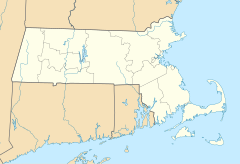 | |
 The testing flume as seen from Race Street, circa 1895 | |
| Established | 1870 |
|---|---|
| Research type | Industrial |
Field of research | Hydraulic engineering |
| Director |
|
| Address | 102 Cabot Street |
| Location | Holyoke, Massachusetts, U.S. 42°11′58″N 72°36′35″W / 42.199580°N 72.609826°W |
| Campus | Holyoke Canal System |
| Affiliations | Holyoke Water Power Company |
| Map | |
The Holyoke Testing Flume was a hydraulic testing laboratory and apparatus in Holyoke, Massachusetts, operated by the Holyoke Water Power Company from 1870 to 1932, and used to test the performance of water turbine designs, completing 3,176 tests of efficiency in that time.[3]: 100 It was described by Robert E. Horton in court testimony as the only facility of its kind in the 19th and early 20th century, which made possible the standardization of American water turbines.[4] Indeed Clemens Herschel, who managed and redesigned the facility in the 1880s, later described it in Congressional testimony as the "first modern hydraulic laboratory" in the United States and the world.[5] It was through Herschel's need to determine the water power consumption of different mills, and in this testing system that he would invent the Venturi meter, the first accurate means of measuring large-scale flows, which still retains widespread use in modern technology today.[5][6]
- ^ Hydraulic Power Company of Niagara Falls v. Pettebone - Cataract Paper Company. Supreme Court of the State of New York. 1915. p. 125.
[Mr. Franchot to Albert F. Sickman:] Q. Are you the chief hydraulic engineer in charge of the Holyoke Water Power Company's work at Holyoke, Mass.?
Mr. Marshall: I object to that conclusion. Counsel is trying to put in his mount a certain loud sounding title which he does not possess...
[Mr. Franchot] Q. The question is, what are you?
[Sickman] A. Hydraulic Engineer in charge of the Holyoke Water Power Company's hydraulic work. - ^ Herschel, Clemens (1916). "Twenty Years' Run-Off, at Holyoke, Mass., of the Connecticut River". Transactions of the American Society of Civil Engineers: 28.
While Hydraulic Engineer of the Holyoke Water Power Company, 1879–1889, the writer instituted a system of keeping a daily record of the discharge of the Connecticut River at Holyoke, which was continued after his departure, by his old-time assistant and successor, A. F. Sickman...
- "Club and Personal Affairs at Holyoke". Springfield Republican. September 20, 1925. p. 5.
Mr. and Mrs. A. F. Sickman of Lincoln street are home from Montreal where they attended the convention of the New England Water Works association which was held in that city
- "Collection of Ferns is Given to Museum". Springfield Republican. Springfield, Mass. December 5, 1927. p. 9.
Mr. Sickman was a great nature lover...during the last days of his life he paid particular attention to the collection of wild ferns.
- "Club and Personal Affairs at Holyoke". Springfield Republican. September 20, 1925. p. 5.
- ^ Barrett, Robert E. The History of the Holyoke Water Power Company; A Subsidiary of Northeast Utilities, 1859-1967 (PDF). Holyoke, Mass. Archived from the original (PDF) on 2019-12-12 – via Holyoke Gas & Electric.
- ^ New York Court of Appeals. Records and Briefs. New York [State] Court of Appeals. 1919. pp. 618–619.
- ^ a b To Establish a National Hydraulic Laboratory. Washington, D.C.: United States Senate Committee on Commerce, US Government Printing Office (GPO). 1922. pp. 58–60.
- ^ Herschel, Clemens (1898). The Venturi Meter (PDF). Providence, R. I.: Builders Iron Foundry.
Cite error: There are <ref group=lower-alpha> tags or {{efn}} templates on this page, but the references will not show without a {{reflist|group=lower-alpha}} template or {{notelist}} template (see the help page).



